Unit 3 How do you get to school? Section A (2a~2e) 课件 (共29张PPT)
文档属性
| 名称 | Unit 3 How do you get to school? Section A (2a~2e) 课件 (共29张PPT) | 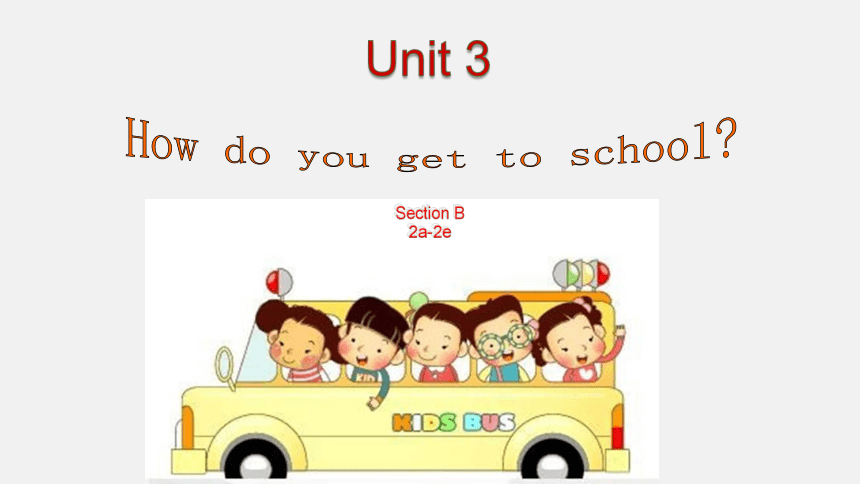 | |
| 格式 | pptx | ||
| 文件大小 | 1.5MB | ||
| 资源类型 | 教案 | ||
| 版本资源 | 人教新目标(Go for it)版 | ||
| 科目 | 英语 | ||
| 更新时间 | 2024-03-20 14:05:49 | ||
图片预览

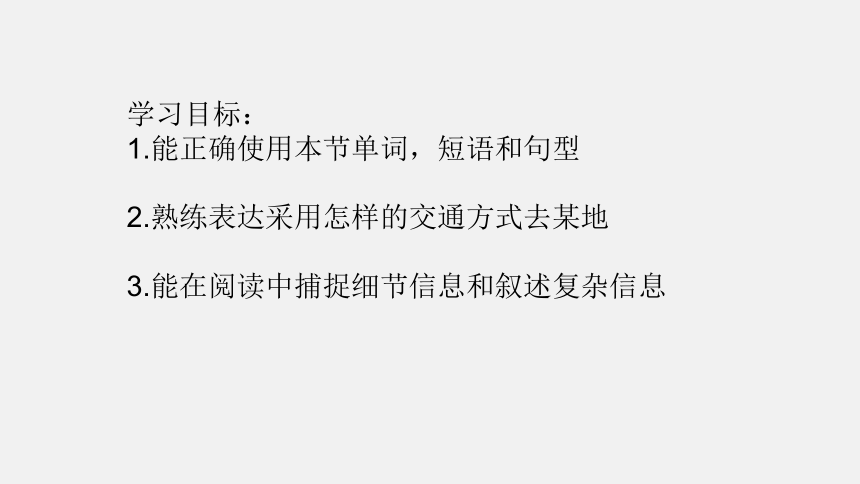
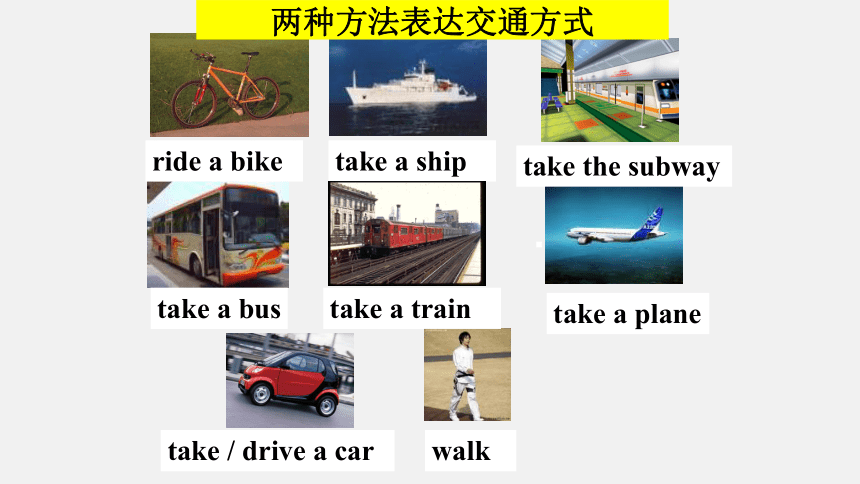
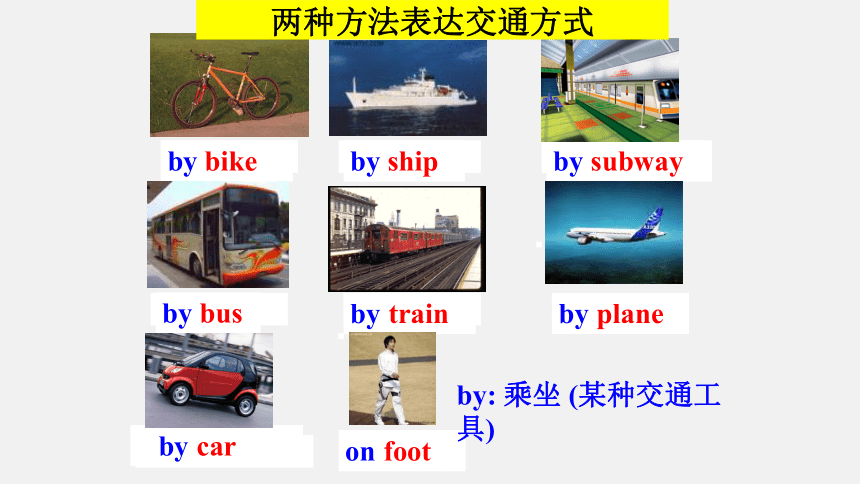
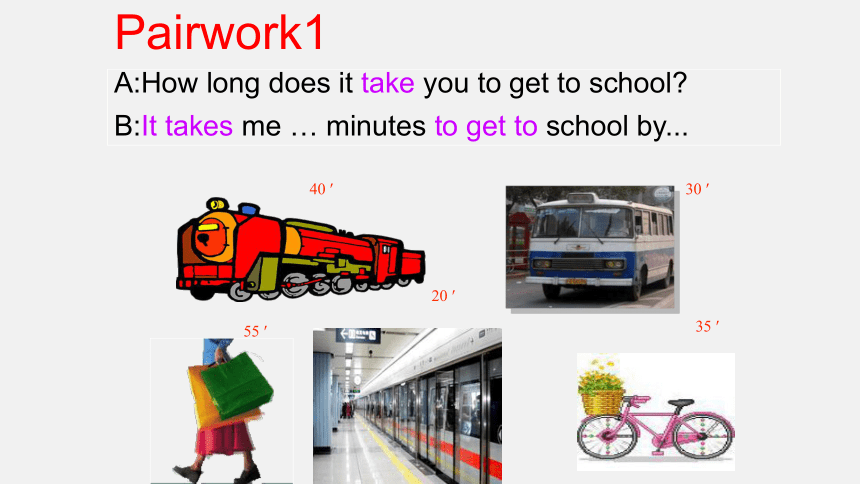
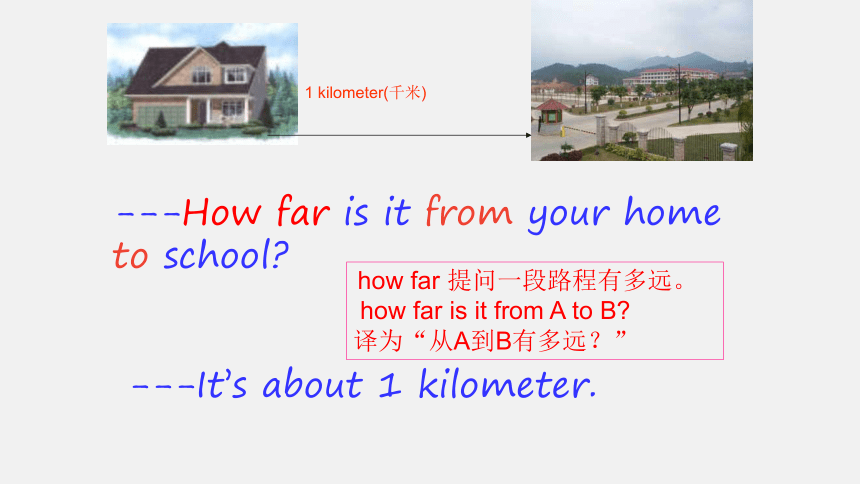
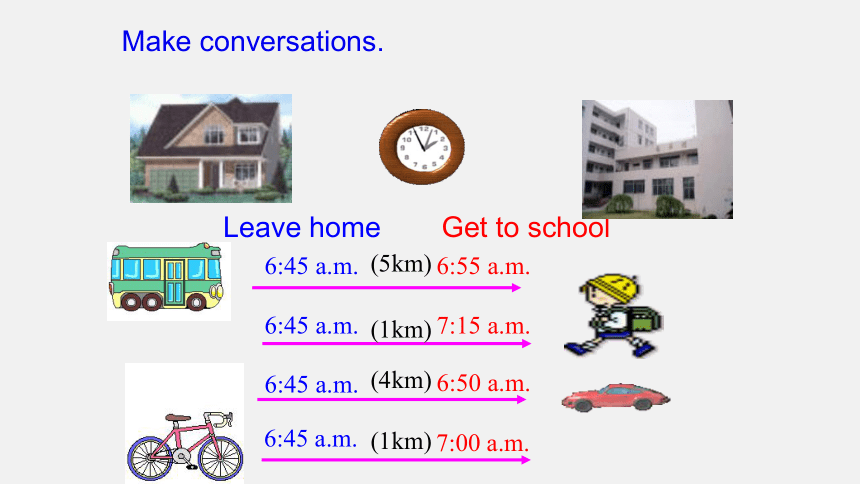
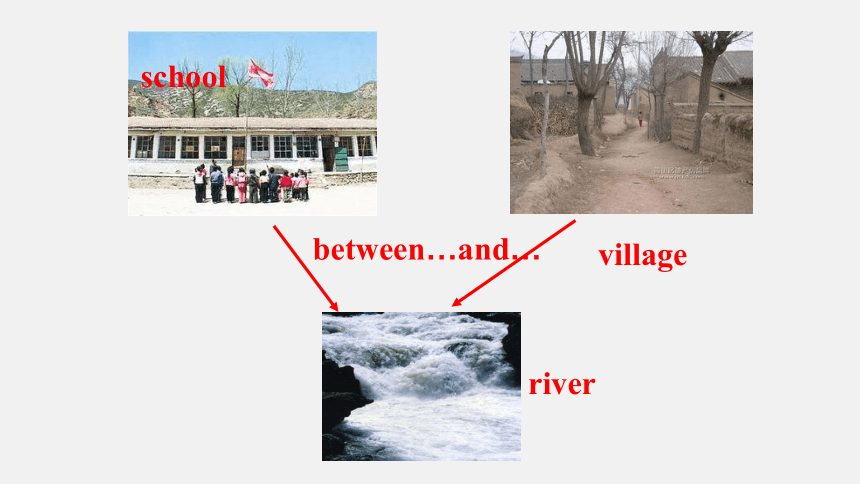
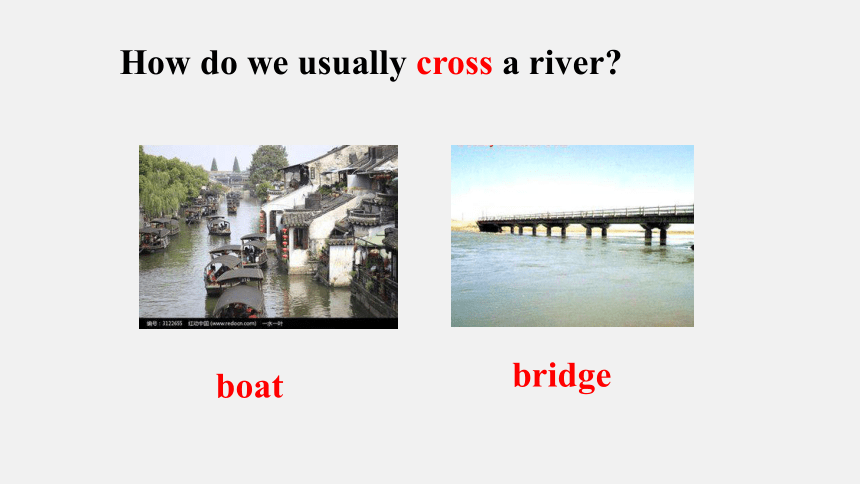
文档简介
(共29张PPT)
How do you get to school
Unit 3
Section B
2a-2e
学习目标:
1.能正确使用本节单词,短语和句型
2.熟练表达采用怎样的交通方式去某地
3.能在阅读中捕捉细节信息和叙述复杂信息
ride a bike
take a ship
take the subway
take a bus
take a train
take a plane
take / drive a car
walk
两种方法表达交通方式
ride a bike
by bike
take a ship
take the subway
take a bus
take a train
take a plane
take / drive a car
walk
on foot
by bus
by train
by ship
by subway
by plane
by car
by: 乘坐 (某种交通工具)
两种方法表达交通方式
A:How long does it take you to get to school
B:It takes me … minutes to get to school by...
30 ′
35 ′
20 ′
55 ′
40 ′
Pairwork1
1 kilometer(千米)
---How far is it from your home to school
---It’s about 1 kilometer.
how far 提问一段路程有多远。
how far is it from A to B
译为“从A到B有多远?”
Leave home
Get to school
6:45 a.m.
7:15 a.m.
6:45 a.m.
6:50 a.m.
Make conversations.
6:45 a.m.
7:00 a.m.
6:45 a.m.
6:55 a.m.
(5km)
(1km)
(4km)
(1km)
village
river
between…and…
school
How do we usually cross a river
boat
bridge
dream
My dream has come true.
boat
river
bridge
village
villager
ropeway
dream
between
100 分
leave
afraid
many = lots of
cross
dream
between
100 分
leave
afraid
many = lots of
cross
Careful reading
1. How do the students in the village go to school
2. Why do they go to school like this
3. Does the boy like this school Why
4. What’s the villagers’ dream Do you think their dream can come true Why or why not
Check the answers
1. They go on a ropeway to cross the river to school.
2. Because there is a big river between their school and the village. There’s no bridge and the river runs too quickly for boats.
3. Yes, he does. He loves to play with his
classmates. He loves his teacher.
4. Their dream is to have a bridge.
Yes. I think so. People all over the world will help them.
Match the main ideas with the paragraphs.
Para1. A. liangliang crosses the river every
school day but he is not afraid.
Para2. B. it is difficult for the students in
the village to get to school.
Para3. C. many of the students and villagers
have a dream.
Task1.
细读每个问题,确定每句话的意思。
2. 带着问题读短文,在短文中寻找相关信息,确定问题回答的依据。
3. 找到答题依据后,再根据问题是一般疑问句还是特殊疑问句来确定如何回答。
4. 最后,再读一遍课文,检查一下答案的正确性。
阅读指导:
1) 首先,阅读句子,掌握句子的意思,大体确定空格处所缺单词的词性,是形容词、名词还是动词等。
2)其次,带着句子,在短文去寻找与句子相关的依据。在相关的句子中寻找空格处所缺的单词。
3) 最后,再读一遍这些句子,看有没有不恰当的地方。
Task2.
Para1.
. It is ______for the students in the village to get to school.
How do the students in the village go to school
2. Why do they go to school like this
There is no bridge, and the river runs too quickly for boats.
They go on a ropeway to cross the river to school.
difficult
Scanning:
While- reading
Para2. Liangliang ___________every school day but he is not ____.
3. Does the boy like his school Why
Yes, he does. Because he loves to play with his classmates. He loves his teacher.
Crosses the river
afraid
Para3.
Many of the students and villagers
have a dream. Can their dream _____.
4. What is the villagers’ dream Do you think their dream can come true How
Their dream is to have a bridge. I think their dream can come true. Maybe the government can build a bridge for them.
come true
1. For many students, it is easy to get to school.
对于许多学生来说,上学很容易。
1) many“许多”,后加可数复数
much 后接不可数名词
lots of=a lot of 后接可数复数和不可数名词
2)A、It’s + adj. + to do sth 句型 “做某事是…..的”,该句中it做形式主语,真正的主语是动词不定式(to do sth )
It’s not easy to cross the river on a ropeway.
用索道过河很不容易。
B、It’s + adj. + for sb to do sth.句型
形容词是描述某事物对某人的影响important(重要的), necessary(必要的), impossible(不可能的), easy, difficult, hard, bad等。
2. There is no bridge and the river runs too quickly for boats.(河上)完全没有桥梁,而且河水湍急,不宜小船摆渡。
1) no 用于构成否定句,主要用于名词之前,强调否定其后的名词,表现“完全不;根本没有。”
There are no computers in that village.
在那个村庄里根本就没有电脑。
There is no milk in the box. 盒子里没有牛奶。
2) run 表示“跑,奔;液体的流动”,在不同语境中分别有不同的用法和含义。例如:
I run to my room and get my bag.
我跑到房间拿自己的提包。
The river runs into the sea.这条河流入大海。
3. One 11-year-old boy“一个11岁的男孩”
11-year-old是由“数词+量词+名词”构成的复合形容词,它一般作定语,其中“year”只能用单数形式。
a four-day trip 一个四天的旅行
a 30-page book 一本30页的书
a three-room house 一个三间屋的房子
1) Maria is (一个13岁的女孩)
2) He is a seven-year-old boy.
=The boy is .
4. between … and … 在…与…之间
between 是个介词,表示在两者之间
如: There is a park between the library and the post office.
5. He’s is like a father to me.对于我来说,他像一个父亲。句中的like作介词,意为“像”。
like 在这里作介词,而不是动词。
be like像; look like看起来像
The baby is like his mother.
= The baby looks like his mother.
这个小婴儿长得像他妈妈。
The fish looks like a big boat.那条鱼看起来像条船
Jane likes history very much.简很喜欢历史
6 .leave v. 离开
① leave后接地点名词,意为“离开某地”。
Mary is leaving Beijing this afternoon. 今天下午玛丽要离开北京。
Please turn off the light when you leave.
当你离开的时候,关一下电灯.
② leave for后接地点名词,意为“离开去某地”。
Mary is leaving for Beijing this afternoon. 今天下午玛丽要启程去北京。
③ leave+地点名词+for+地点名词,意为“离开某地去某地”。
Mary is leaving Wuhan for Beijing this afternoon. 今天下午玛丽要离开武汉去北京 .
( )1. For some students, it’s easy_________ home.
A. to get B. get to C. to get to D. get
( )2. Many people ________animals, because dogs
_____ friends to them.
A.like, like B. are like, like
C. like, are like D. are like , are like
( )3. My new classmate is__________ girl.
A. a 8 year old B. an 8-years-old
C. a 8 years old D. an 8-year-old
( )4. Do you walk to work or go by taxi ________.
I want to exercise.
A. Yes, I do. B. No, I don’t.
C. I go to work on foot. D. I take a taxi to work.
A
C
D
C
( )5. Their dream is_____________ a bridge.
A. to have B. have C. having D. to having
( )6. There are 200_________in the small_______.
A. villages, village B. villager, village
C. village, villager D. villagers, village
( )7. The train ______ the train station at 8:40 every
morning.
A. gets B. runs C. comes D. leaves
A
D
D
Thanks for your listening!
How do you get to school
Unit 3
Section B
2a-2e
学习目标:
1.能正确使用本节单词,短语和句型
2.熟练表达采用怎样的交通方式去某地
3.能在阅读中捕捉细节信息和叙述复杂信息
ride a bike
take a ship
take the subway
take a bus
take a train
take a plane
take / drive a car
walk
两种方法表达交通方式
ride a bike
by bike
take a ship
take the subway
take a bus
take a train
take a plane
take / drive a car
walk
on foot
by bus
by train
by ship
by subway
by plane
by car
by: 乘坐 (某种交通工具)
两种方法表达交通方式
A:How long does it take you to get to school
B:It takes me … minutes to get to school by...
30 ′
35 ′
20 ′
55 ′
40 ′
Pairwork1
1 kilometer(千米)
---How far is it from your home to school
---It’s about 1 kilometer.
how far 提问一段路程有多远。
how far is it from A to B
译为“从A到B有多远?”
Leave home
Get to school
6:45 a.m.
7:15 a.m.
6:45 a.m.
6:50 a.m.
Make conversations.
6:45 a.m.
7:00 a.m.
6:45 a.m.
6:55 a.m.
(5km)
(1km)
(4km)
(1km)
village
river
between…and…
school
How do we usually cross a river
boat
bridge
dream
My dream has come true.
boat
river
bridge
village
villager
ropeway
dream
between
100 分
leave
afraid
many = lots of
cross
dream
between
100 分
leave
afraid
many = lots of
cross
Careful reading
1. How do the students in the village go to school
2. Why do they go to school like this
3. Does the boy like this school Why
4. What’s the villagers’ dream Do you think their dream can come true Why or why not
Check the answers
1. They go on a ropeway to cross the river to school.
2. Because there is a big river between their school and the village. There’s no bridge and the river runs too quickly for boats.
3. Yes, he does. He loves to play with his
classmates. He loves his teacher.
4. Their dream is to have a bridge.
Yes. I think so. People all over the world will help them.
Match the main ideas with the paragraphs.
Para1. A. liangliang crosses the river every
school day but he is not afraid.
Para2. B. it is difficult for the students in
the village to get to school.
Para3. C. many of the students and villagers
have a dream.
Task1.
细读每个问题,确定每句话的意思。
2. 带着问题读短文,在短文中寻找相关信息,确定问题回答的依据。
3. 找到答题依据后,再根据问题是一般疑问句还是特殊疑问句来确定如何回答。
4. 最后,再读一遍课文,检查一下答案的正确性。
阅读指导:
1) 首先,阅读句子,掌握句子的意思,大体确定空格处所缺单词的词性,是形容词、名词还是动词等。
2)其次,带着句子,在短文去寻找与句子相关的依据。在相关的句子中寻找空格处所缺的单词。
3) 最后,再读一遍这些句子,看有没有不恰当的地方。
Task2.
Para1.
. It is ______for the students in the village to get to school.
How do the students in the village go to school
2. Why do they go to school like this
There is no bridge, and the river runs too quickly for boats.
They go on a ropeway to cross the river to school.
difficult
Scanning:
While- reading
Para2. Liangliang ___________every school day but he is not ____.
3. Does the boy like his school Why
Yes, he does. Because he loves to play with his classmates. He loves his teacher.
Crosses the river
afraid
Para3.
Many of the students and villagers
have a dream. Can their dream _____.
4. What is the villagers’ dream Do you think their dream can come true How
Their dream is to have a bridge. I think their dream can come true. Maybe the government can build a bridge for them.
come true
1. For many students, it is easy to get to school.
对于许多学生来说,上学很容易。
1) many“许多”,后加可数复数
much 后接不可数名词
lots of=a lot of 后接可数复数和不可数名词
2)A、It’s + adj. + to do sth 句型 “做某事是…..的”,该句中it做形式主语,真正的主语是动词不定式(to do sth )
It’s not easy to cross the river on a ropeway.
用索道过河很不容易。
B、It’s + adj. + for sb to do sth.句型
形容词是描述某事物对某人的影响important(重要的), necessary(必要的), impossible(不可能的), easy, difficult, hard, bad等。
2. There is no bridge and the river runs too quickly for boats.(河上)完全没有桥梁,而且河水湍急,不宜小船摆渡。
1) no 用于构成否定句,主要用于名词之前,强调否定其后的名词,表现“完全不;根本没有。”
There are no computers in that village.
在那个村庄里根本就没有电脑。
There is no milk in the box. 盒子里没有牛奶。
2) run 表示“跑,奔;液体的流动”,在不同语境中分别有不同的用法和含义。例如:
I run to my room and get my bag.
我跑到房间拿自己的提包。
The river runs into the sea.这条河流入大海。
3. One 11-year-old boy“一个11岁的男孩”
11-year-old是由“数词+量词+名词”构成的复合形容词,它一般作定语,其中“year”只能用单数形式。
a four-day trip 一个四天的旅行
a 30-page book 一本30页的书
a three-room house 一个三间屋的房子
1) Maria is (一个13岁的女孩)
2) He is a seven-year-old boy.
=The boy is .
4. between … and … 在…与…之间
between 是个介词,表示在两者之间
如: There is a park between the library and the post office.
5. He’s is like a father to me.对于我来说,他像一个父亲。句中的like作介词,意为“像”。
like 在这里作介词,而不是动词。
be like像; look like看起来像
The baby is like his mother.
= The baby looks like his mother.
这个小婴儿长得像他妈妈。
The fish looks like a big boat.那条鱼看起来像条船
Jane likes history very much.简很喜欢历史
6 .leave v. 离开
① leave后接地点名词,意为“离开某地”。
Mary is leaving Beijing this afternoon. 今天下午玛丽要离开北京。
Please turn off the light when you leave.
当你离开的时候,关一下电灯.
② leave for后接地点名词,意为“离开去某地”。
Mary is leaving for Beijing this afternoon. 今天下午玛丽要启程去北京。
③ leave+地点名词+for+地点名词,意为“离开某地去某地”。
Mary is leaving Wuhan for Beijing this afternoon. 今天下午玛丽要离开武汉去北京 .
( )1. For some students, it’s easy_________ home.
A. to get B. get to C. to get to D. get
( )2. Many people ________animals, because dogs
_____ friends to them.
A.like, like B. are like, like
C. like, are like D. are like , are like
( )3. My new classmate is__________ girl.
A. a 8 year old B. an 8-years-old
C. a 8 years old D. an 8-year-old
( )4. Do you walk to work or go by taxi ________.
I want to exercise.
A. Yes, I do. B. No, I don’t.
C. I go to work on foot. D. I take a taxi to work.
A
C
D
C
( )5. Their dream is_____________ a bridge.
A. to have B. have C. having D. to having
( )6. There are 200_________in the small_______.
A. villages, village B. villager, village
C. village, villager D. villagers, village
( )7. The train ______ the train station at 8:40 every
morning.
A. gets B. runs C. comes D. leaves
A
D
D
Thanks for your listening!
同课章节目录
- Unit 1 Can you play the guitar?
- Section A
- Section B
- Unit 2 What time do you go to school?
- Section A
- Section B
- Unit 3 How do you get to school?
- Section A
- Section B
- Unit 4 Don't eat in class.
- Section A
- Section B
- Unit 5 Why do you like pandas?
- Section A
- Section B
- Unit 6 I'm watching TV.
- Section A
- Section B
- Review of Units 1-6
- Unit 7 It's raining!
- Section A
- Section B
- Unit 8 Is there a post office near here?
- Section A
- Section B
- Unit 9 What does he look like?
- Section A
- Section B
- Unit 10 I'd like some noodles.
- Section A
- Section B
- Unit 11 How was your school trip?
- Section A
- Section B
- Unit 12 What did you do last weekend?
- Section A
- Section B
